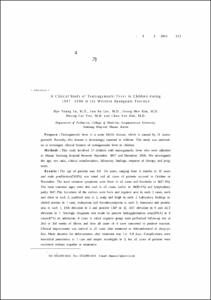최근 4년간 서부 경남지역의 소아에서 발생한 쯔쯔가무시열의 임상적 고찰
- Keimyung Author(s)
- Kim, Chun Soo
- Department
- Dept. of Pediatrics (소아청소년학)
- Journal Title
- 소아감염
- Issued Date
- 2001
- Volume
- 8
- Issue
- 2
- Keyword
- Tsutsugamushi fever; Children
- Abstract
- Propose : Tsutsugamushi fever is a acute febrile disease, which is caused by O. tsutsugamushi. Recently, this disease is increasingly reported in children. This study was undertaken to investigate clinical features of tsutsugamushi fever in children. Methods : This study involved 17 children with tsutsugamushi fever who were admitted to Masan Samsung hospital between September 1997 and December 2000. We investigated the age, sex ratio, clinical manifestations, laboratory findings, response of therapy and prognosis. Results : The age of patients was $6.9{\pm}3.6$ years, ranging from 6 months to 12 years and male predilection(58.8%) was noted and all cases of patients occured in October or November. The most common symptoms were fever in all cases and headache in 8(47.1%). The most common signs were skin rash in all cases, eschar in 14(82.4%) and lymphadenopathy 8(47.1%). Locations of the eschars were back and inguinal area in each 3 cases, neck and chest in each 2, popliteal area in 2, scalp and thigh in each 1. Laboratory findings included anemia in 1 case, leukopenia and thrombocytopenia in each 5, hematuria and proteinuria in each 1, ESR elevation in 2 and positive CRP in 12, AST elevation in 9 and ALT elevation in 7. Serologic diagnosis was made by passive hemagglutination assay(PHA) in 8 cases(47%) on admission, 4 cases in initial negative group were performed follow-up test at 2nd or 3rd weeks of illness and then all cases of 4 were converted to positive reaction. Clinical improvement was noticed in all cases after treatment to chloramhenicol or doxycycline. Mean duration for defervescence after treatment was $1.4{\pm}0.8$ days. Complications were interstitial pneumonia in 1 case and aseptic meningitis in 3, but all cases of patients were recovered without sequelae or recurrence. Conclusions : Tsutsugamushi fever in children was similiar to adult in the clinical features except male predilection. Early diagnosis and empirical treatment based on clinical manifestations such as fever, skin rash, eschar, lymphadenopathy is important and serologic diagnosis need to perform follow-up test at 2nd or 3rd weeks of illness.
목 적 : 급성 열성 질환으로 입원한 환아들 중 임상적 또는 혈청학적 소견상 쯔쯔가무시열로 진단된 17례의 임상양상을 조사하여 소아에서 발진을 동반한 급성 발열성 질환의 감별에 있어서 쯔쯔가무시열의 조기진단과 치료에 도움을 주고자 본 연구를 시행하였다. 방 법 : 1997년 9월부터 2000년 12월까지 성균관대학교 마산삼성병원 소아과에 급성 열성 질환으로 입원한 환아들 중 임상적 또는 혈청학적 소견상 쯔쯔가무시열로 진단된 17례를 대상으로 성별 및 연령 분포, 발생시기, 임상증상, 검사소견, 치료결과 등을 후향적으로 분석하였다. 쯔쯔가무시열의 임상적 진단기준은 1일 이상의 발열을 주소로 입원한 환아들 중 최근 3주내 유행지역에 노출된 병력이 있으면서 반점 구진상의 피부 발진과 가피, 림프절 종대 등의 특징적인 진찰소견이 동반된 환아들로 제한하였다. 혈청학적 진단기준은 O.tsutsugamushi 항원 감작 면양 적혈구를 이용한 수동혈구응집반응검사(PHA)인 Genedia tsutsugamushi PHA 2 kit(녹십자, 한국)를 이용하였는데 O.tsutsugamushi 항체가 가 1 : 80 이상이면 양성으로 판정하였고, 양성으로 판정된 검체는 1 : 5,120까지 계단 희석하여 항체가의 변화를 정량 분석하였다. 또한 Hantann virus와 Leptospira에 대한 혈청학적 검사도 동시에 시행하였다. 결 과 : 연구군 17례의 연령 분포는 6개월부터 12세까지로 평균 연령은 $6.9{\pm}3.6$세였으며 성별은 남아가 10례(58.8%), 여아가 7명(41.2%)으로 남아에서 많았다. 발생 시기는 10월에 7명, 11월에 10명으로 전례에서 10~11월에 발생하였고, 환아들 중 14명은 유행지역의 외부환경에 노출된 병력이 있었다. 임상증상은 발열이 전례에서 있었는데 입원 전 발열기간은 2~8(평균 $5.2{\pm}1.7$)일의 분포를 보였고 그 외에 두통, 기침, 소양감, 콧물, 복통, 구토, 설사 등이 있었으며 진찰소견은 피부 발진이 전례에서 있었고 그 외에 가피, 림프절 종대, 결막 충혈, 인후 발적, 피부의 막양 낙설, 간 비대, 발의 부종 등의 순으로 관찰되었다. 가피는 14례에서 관찰되었는데 등과 서혜부가 각각 3례로 가장 많았고 그 외에 경부, 가슴, 슬와부, 두부, 대퇴부 등에서 발견되었다. 말초혈액 검사상 빈혈은 1례에서 관찰되었고 백혈구 감소와 혈소판 감소는 각각 5례에서 보였다. 소변검사에서는 혈뇨와 단백뇨가 각각 1례에서 있었고, 급성기 반응으로 ESR은 단지 2례에서 상승되었으나 CRP는 12례에서 양성이었으며, 간기능 검사상 AST와 ALT치는 각각 9례와 7례에서 증가되었다. 혈청학적 검사(PHA)상 입원 당시의 양성반응은 8례(47%)였으며 발열기간에 따른 양성율은 7일 미만군(38.5%)에 비해서 7일 이상군(75%)에서 더 높았으나 유의성은 없었고 입원 당시 음성반응이었던 9례 중 발병 후 2~3주경에 추적검사한 4명에서는 모두 양성반응으로 전환되었다. 치료는 8세 미만인 9례에서는 chloramphenicol(25 mg/kg)을 8시간 간격으로 정맥 주사하였고, 8세 이상인 8례에서는 doxycycline(5 mg/kg/day)을 2회로 나누어서 경구 투여하였으며 해열 후 4일까지 투여하였다. 치료 후 해열에 걸리는 기간은 chloramphenicol군 : $1.3{\pm}0.6$일, doxycycline군 : $1.5{\pm}1.0$일로 두 군에서 비슷하였다. 합병증은 간질성 폐렴이 1명, 무균성 뇌수막염이 3명 있었으나 17명 전례에서 휴유증이나 재발 없이 완쾌되었다. 결 론 : 소아 쯔쯔가무시열의 발생시기와 임상양상은 성인과 유사하나 소아에서는 남아에서 발생율이 더 높은 차이점이 있었다. 또한 PHA에 의한 검사는 발병 1주내에는 민감도가 낮으므로 유행지역에 노출된 병력이 있는 소아에서는 발열, 발진, 가피, 림프절 종대 등의 특징적 임상소견에 의한 조기진단과 적극적인 치료가 중요하며, 발병 2~3주경에 반복적 검사에 의한 혈청학적 확진이 필요하다고 생각된다.
- Alternative Title
- A Clinical Study of Tsutsugamushi Fever in Children during 1997~2000 in the Western Kyungnam Province
- Keimyung Author(s)(Kor)
- 김천수
- Publisher
- School of Medicine
- Citation
- 주혜영 et al. (2001). 최근 4년간 서부 경남지역의 소아에서 발생한 쯔쯔가무시열의 임상적 고찰. 소아감염, 8(2), 213–221.
- Type
- Article
- ISSN
- 1226-3923
- Appears in Collections:
- 1. School of Medicine (의과대학) > Dept. of Pediatrics (소아청소년학)
- 파일 목록
-
-
Download
 oak-bbb-4520.pdf
기타 데이터 / 129.3 kB / Adobe PDF
oak-bbb-4520.pdf
기타 데이터 / 129.3 kB / Adobe PDF
-
Items in Repository are protected by copyright, with all rights reserved, unless otherwise indicated.